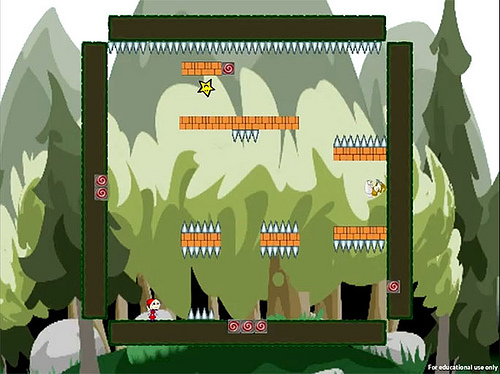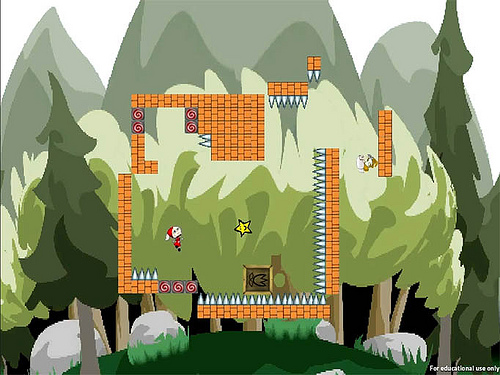Red Rolling Hood alpha was a direct consequence of the design decisions we made during the prototype. At this point, the game was a puzzle game with a lot of jumping platform elements. You can see that in the video below.
At the time this video was made, we had created around 70 levels, mostly end game levels. The reason we were aiming for end game content during the beginning of the production is because it is actually much easier to create something complex than create something simple. Also, this allowed us to understand and get used to the mechanics and features of the game.
After our first “mass” playtesting we realized a few problems. The puzzles were unnecessarily complex, the rotation ability was still too easily available, and the player’s jumping air-control was too much control. It was still very hard to create levels that couldn’t be broken with all these problems. The lack of level conventions also proved to be an issue. Players had no idea what was the proper way to solve the levels, or how to understand and explore the more advanced features.
In order to solve the air control issue we created 2 types of fall, the jump-fall and the free-fall. The jump-fall is the fall that comes from the player jumping. During the jumping-fall the player has a good amount of air control, which helps to navigate around the levels. The second type of fall is the free-fall, which is a fall where the player doesn’t jump first. For example, walk off a platform, or rotate the level upside down and just fall. With the free-fall, the player has very limited to none air control, which makes much harder to break the levels.
Removing the air control during the free fall essentially removed the player’s ability to fly using the level rotation. With this fix, the player would have to use the rotations more strategically.
The second limitation we added was the activation of the spinning/rotation power. During alpha, all the player had to do is to be close a rotating block, in order to activate the spinning ability, even while falling or jumping. We changed that so the player had to stand on top of a rotating platform in order to activate the spinning power, and it couldn't be falling or jumping. This severely limited the player’s ability to reach to rotation blocks, forcing them to be more creative in the ways to reach the rotation blocks. Also, now that the player no longer could activate the rotation power while jumping or falling, the player could no longer fly around the level by falling from rotation block to rotation block.
We also started to create many level design conventions for placement and size of objects, features usage and for overall level indication. Those conventions were first introduced by the end of the alpha stage, and were slowly and constantly updated until the end of our beta stage.
The very first convention we created was the standardization for size and positioning of rotation blocks. Initially this was more an aesthetic problem, the game just looked better by limiting the size and position of blocks. However, improving the looks of the game also helped players to make better use of resources available in the levels.
We also started to use the geometry of the level to create safety nets for certain actions, clear paths for boxes, and guide player with threat and safety. The convention for level difficulty escalation was hard to get. It took us several playtesting sessions with friends to start to grasp what a hard level really was.
Eventually we realized that complex puzzles weren't necessarily good puzzles. We started to focus on creating difficulty out of simplicity, rather than relying on unnecessarily complexity, or just a large number of puzzle elements. Those were our very first design conventions we worked on, but other conventions eventually were made during the beta stages of the game.
When we put all those changes together, and looked back on the game, we realized most of the levels we created had to be tossed away. They were so far away from the conventions we had just created, that it was much easier start new levels than fix the old ones. While it was certainly sad get rid of so many levels, we certainly learnt a lot from that entire process, and we were ready for the next step of production.




